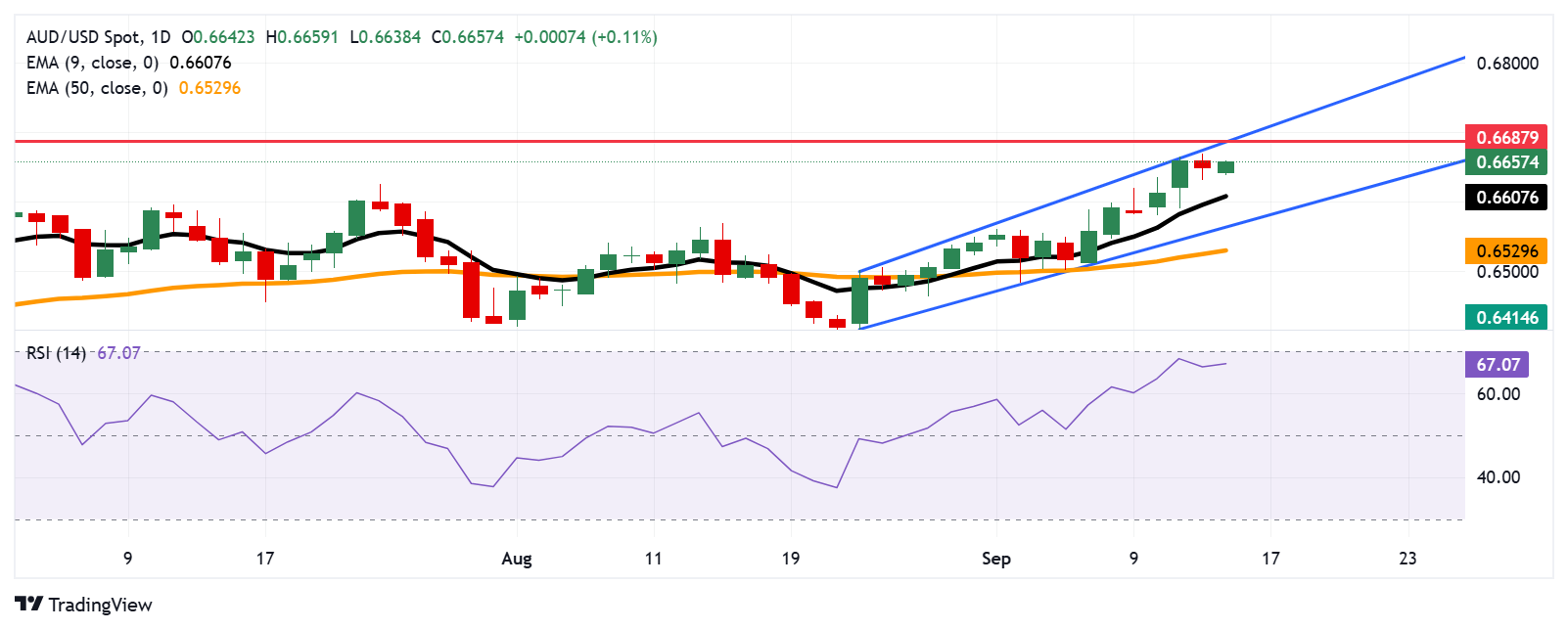Australian Dollar holds gains following weaker-than-expected China’s economic data
- Australian Dollar receives support from waning odds of further RBA rate cuts.
- China’s Retail Sales climbed 3.4% YoY in August, against 3.8% expected and 3.7% in July.
- US labor market increases the chances of the Federal Reserve delivering its first rate cut of the year on Thursday.
The Australian Dollar (AUD) inches higher against the US Dollar (USD) on Monday, recovering its losses registered in the previous session. The AUD/USD pair holds ground following disappointing economic data from Australia’s close trading partner, China.
The National Bureau of Statistics (NBS) showed Monday that China’s Retail Sales rose 3.4% year-over-year (YoY) in August vs. 3.8% expected and 3.7% in July. Chinese Industrial Production increased 5.2% YoY in the same period, compared to the 5.8% forecast and 5.7% seen previously.
The AUD finds support on diminishing expectations of further Reserve Bank of Australia (RBA) rate cuts. Swaps now price in an 86% likelihood of unchanged policy in September, bolstered by Australia’s strong July trade surplus, solid Q2 GDP, and hotter July inflation.
Australia’s Consumer Inflation Expectations also climbed in September, signaling stronger domestic demand and raising concerns about renewed inflationary pressures. RBA Governor Michele Bullock noted that the private sector is showing “a little bit more growth,” which she described as a positive sign for the economy.
US Treasury Secretary Scott Bessent, Trade Representative Jamieson Greer, and their Chinese counterpart, Vice Premier He Lifeng, discussed trade and the economy during high-level talks in Madrid. Traders will be watching closely as the US-China talks move into their second day.
Australian Dollar advances as market mood improves on Fed rate cut odds
- The US Dollar Index (DXY), which measures the value of the US Dollar against six major currencies, is holding ground and trading around 97.60 at the time of writing. The US Dollar may struggle as a weakening US labor market boosts the likelihood of the US Federal Reserve (Fed) delivering its first rate cut of the year on Thursday.
- Traders are also monitoring whether Stephen Miran will be sworn in as a Fed governor before the meeting. According to Reuters, citing the Senate schedule set by Republican leaders, the full Senate vote on his confirmation is scheduled for Monday evening.
- The US Federal Reserve (Fed) is expected to lower rates by 25 basis points at its September meeting, though there remains a slight chance of a 50-basis-point cut. Markets have also factored in continued easing through 2026 to help stave off a potential recession.
- Morgan Stanley and Deutsche Bank now expect the US central bank to deliver three rate cuts this year, after recent data pointed to easing inflation pressures. In separate notes on Friday, the brokerages projected 25-basis-point reductions at each of the Fed’s remaining meetings in September, October, and December, according to Reuters.
- Bets on multiple Fed rate cuts strengthened after US Weekly Initial Jobless Claims climbed to their highest since October 2021, following last week’s weak Nonfarm Payrolls report, overshadowing a hotter-than-expected consumer inflation reading.
- US Consumer Price Index (CPI) climbed 2.9% year-over-year in August, as expected, but came in higher than 2.7% in July. On a monthly basis, the CPI inflation climbed to 0.4% from a 0.2% increase prior. The core CPI, which excludes volatile food and energy prices, increased 3.1% on a yearly basis in August, matching the estimate.
- US Initial Jobless Claims rose to 263K, the highest since 2021, against the expected 235K and 236K prior (revised from 237K).
- The US Bureau of Labor Statistics’ (BLS) preliminary estimate of the Current Employment Statistics (CES) national benchmark revision suggests total Nonfarm employment for March 2025 will likely be revised down by 911,000, or about 76,000 fewer jobs per month, signaling a weaker labor market than previously estimated. The final benchmark revision will be issued in February 2026 with the publication of the January 2026 Employment Situation news release," the BLS noted in its press release.
Australian Dollar targets 11-month highs near 0.6700
AUD/USD is trading around 0.6660 on Monday. The technical analysis of the daily chart shows the pair moves upwards within an ascending channel pattern, indicating the market bias is bullish. Additionally, the pair is positioned above the nine-day Exponential Moving Average (EMA), indicating short-term price momentum is stronger.
On the upside, the AUD/USD pair may approach the 11-month high of 0.6687, recorded in November 2024, followed by the upper boundary of the ascending channel around 0.6700.
The initial support lies at the nine-day EMA of 0.6607, followed by the ascending channel’s lower boundary around 0.6570. A break below the channel would weaken the short-term price momentum and lead the AUD/USD pair to test the 50-day EMA at 0.6529.
AUD/USD: Daily Chart

Economic Indicator
Retail Sales (YoY)
The Retail Sales data, released by the National Bureau of Statistics of China on a monthly basis, measures the value of goods sold by retailers in China. Changes in Retail Sales are widely followed as an indicator of consumer spending. Percent changes reflect the rate of changes in such sales, with the YoY reading comparing sales values in the reference month with the same month a year earlier. Generally, a high reading is seen as bullish for the Renminbi (CNY), while a low reading is seen as bearish.
Read more.Last release: Mon Sep 15, 2025 02:00
Frequency: Monthly
Actual: 3.4%
Consensus: 3.8%
Previous: 3.7%
Source: National Bureau of Statistics of China
